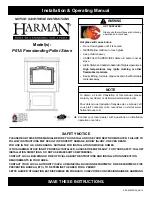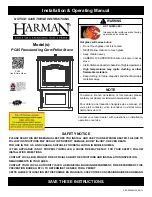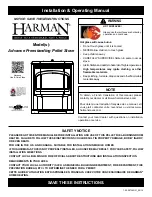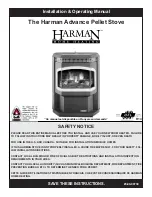
8
Heatilator • ECO-ADV-WS22 • 7057-128D • September 15, 2011
B. Fire Safety
To provide reasonable fi re safety, the following should be
given serious consideration:
1. Install at least one smoke detector on each fl oor of
your home to ensure your safety. They should be
located away from the heating appliance and close
to the sleeping areas. Follow the smoke detector
manufacturer’s placement and installation instructions,
and be sure to maintain regularly.
2.
A conveniently located Class A fi re extinguisher.
3.
A practiced evacuation plan, consisting of at least two
escape routes.
4.
In the event of a chimney fi re:
a.
Prepare occupants for immediate evacuation
b. Notify
fi re department
D. Combustible/Non-combustible Materials
•
Combustible Material
Material made of or surfaced with wood, compressed
paper, plant fi bers, plastics, or any material capable
of igniting and burning, whether fl ame-proofed or not,
plastered or unplastered.
•
Non-combustible Material
Material which will not ignite and burn. Such materials are
those consisting entirely of steel, iron, brick, tile, slate,
glass or plasters, or any combination thereof.
•
Non-combustible Sealant Material
Sealants which will not ignite and burn: Rutland, Inc.
Fireplace Mortar #63, Rutland 76R, Nuflex 304, GE
RTV106 or GE RTB116 (or equivalent).
E. Seasoned Wood
Burn only dry seasoned wood.
• Store wood under cover, out of the rain and snow.
• Dry and well-seasoned wood will not only minimize the
chance of creosote formation, but will give you the most
effi cient fi re.
• Even dry wood contains at least 15% moisture by weight,
and should be burned hot enough to keep the chimney
hot for as long as it takes to dry the wood out - about one
hour.
• It is a waste of energy to burn unseasoned wood of any
kind.
Dead wood lying on the forest fl oor should be considered wet,
and requires full seasoning time.
• Standing dead wood can be considered to be about 2/3
seasoned.
• To tell if wood is dry enough to burn, check the ends of
the logs.
•
If there are cracks radiating in all directions from the center,
it is dry.
• If your wood sizzles in the fi re, even though the surface
is dry, it may not be fully cured.
C. Overfi ring
Do not over-fi re.
Over-fi ring may ignite creosote or will damage the
stove and chimney.
To prevent over-fi ring your stove, DO NOT:
• Use
fl ammable liquids
• Overload with wood
• Burn trash or large amounts of scrap lumber
• Permit too much air to the fi re
WARNING! Risk of Fire!
Symptoms of over-fi ring may include one or more of the
following:
• Chimney connector or appliance glowing
• Roaring, rumbling noises
• Loud cracking or banging sounds
• Metal
warping
• Chimney
fi re
1. Symptoms of Over-Firing
2. What To Do if Your Stove is Over-Firing
• Immediately close the door and air controls to reduce
air supply to the fi re.
• If you suspect a chimney fi re, call the fi re department
and evacuate your house.
• Contact your local chimney professional and have
your stove and stove pipe inspected for any damage.
• Do not use your stove until the chimney professional
informs you it is safe to do so.
Hearth & Home Technologies
WILL NOT
warranty stoves
that exhibit evidence of over-fi ring. Evidence of over-fi ring
includes, but is not limited to:
• Warped air tube
• Deteriorated refractory brick retainers
• Deteriorated
baffl e and other interior components
F. Chimney Fire
WARNING! Risk of Fire! A chimney fi re can permanently
damage your chimney system and nearby structures.
In the event of a chimney fi re, Hearth & Home Technolo-
gies Inc. recommends
• Replacement of the chimney, and
• Inspection of the adjacent structure to the provisions of
NFPA Level III inspection criteria









































